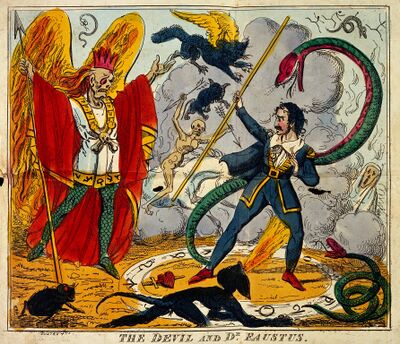Playing with Fire
Theatre and pyrotechnics
Fire is humankind’s oldest form of illumination, representing warmth and safety, but also danger, the diabolical and the supernatural. In the Renaissance theatre, pyrotechnics created spectacular effects, and brought the diabolical on stage.
The term pyrotechnics comes from the Greek words pyr (‘fire’) and tekhnikos (‘made by art’). Explosions, flashes, flames and other pyrotechnic effects have been used in the theatre since before the Renaissance. It is believed that fireworks originated in China around the 9th century, although they were also used in ancient India. In the Middle Ages, fireworks had begun to be manufactured in Italy. In the 14th century, fireworks were used for religious events, celebrations and public festivals. Increasingly complex displays were created by ‘fire masters’, trained in newly established pyrotechnic schools across Europe.
The first written description of fireworks displays in Europe are from 1379, describing a performance in front of the bishop’s palace in the city of Vicenza, which had a great impact on the audience:
There was a flash and a loud thunder-clap, and straight away there descended down this rope the image of a shining dove. Almost all fell to the ground in terror and amazement, beseeching God in hymns and chants that the holy spirit should descend upon them according to the prophesies.
Perhaps the most popular type of pyrotechnic in the Renaissance period was the squib – also known as a serpent, rocket, or fizgig. A small tube of paper was filled with gunpowder, with a fuse running the length of the tube. When lit, squibs produced a bright, short burst of flame, and a powerful and unpleasant smell. If not held onto, they shot around erratically. The squib was one of many types of pyrotechnic devices used as part of theatre performances, creating a multi-sensory experience for the audience, involving light, sound, fire, smoke, heat and smell.
In 1611, Sebastio Serlio (Q568) described a pyrotechnic lightning effect in his First Book of Architecture:
Lightning must be made in this manner, there must be a man placed behind the Scene or Scaffold in a high place with a boxe in his hand, the cover whereof must be full with holes, and in the middle of that place there shall be a burning candle placed, the boxe must be filled with powder of vernis [i.e., varnish, resin] or sulphire, and casting his hand with the boxe upwards the powder flying in the candle, will shew as if it were lightning. But touching the beames of the lightning, you must draw a piece of wyre over the Scene, which must hang downewards, whereon you must put a squib covered over with pure gold or shining lattin [sheet tin] which you will: and while the Bullet is rouling, you must shoote of some piece of Ordinance, and with the same giving fire to the squibs, it will worke the effect which is desired.
Squibs were not only used to create natural effects such as lightning, they also created the supernatural, being especially associated with the devil. Often, pyrotechnics were shown in the orifices of devils on stage, as they emerged from smoke and fumes. In the play The Tragical History of the Life and Death of Doctor Faustus by Christopher Marlowe (Q30567), pyrotechnics are associated with Mephistophilis and his devils. In an eyewitness account of a performance by John Melton, devils are described rushing about the stage ‘with squibs in their mouthes.’ At another point in the play, Mephistophilis enters, and ‘sets squibs at their backs’, and when Faustus signs his contract with the Devil, Mephistophilis holds ‘a Chafer of Fire.’ Mephistophilis also enters ‘with fire-workes’.
Later in the play, Faustus himself controls fire, for example when attacking the friars with fireworks. He casts a spell that invokes the appearance of a dragon on stage – a pyrotechnic effect well-established since the Middle Ages. Later, an ‘ever-burning’ chair descends onto the stage. Finally, at the end of the play, Hell is discovered and a flaming ‘Hell mouth’ appears. Pyrotechnics were central to the late 16th century staging of Dr Faustus, not only for their ability to create spectacular effects that would impress and excite an audience, but also for their symbolic value, to conjure the idea of diabolical forces at work.
As well as pyrotechnics made with gunpower, saltpetre, sulphur and such materials, theatre-makers in the Renaissance period had another technique to make flames on stage. Lycopodium powder (Q30584) consists of the dry spores of clubmoss plants. When it is mixed with air, the spores are highly flammable and are used to create dust explosions, as the spores have a large surface area per unit of volume and a high fat content. The principal use of the powder is to create flashes or flames that are large and impressive but relatively easy to manage safely in magic acts and theatrical special effects.
Pyrotechnics have been used in performances since the 14th century, whenever spectacular effects are required, for events such as festivals and celebrations. Their dramatic power also continues to be used when there is a need to invoke the menacing, dangerous, unearthly, or supernatural.

